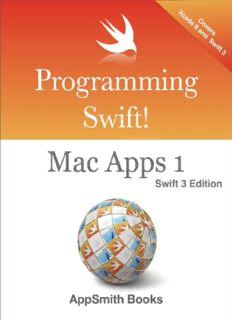Table Of ContentProgramming Swift! Mac Apps 1
Swift 3 Edition
by Nick Smith
ISBN: 978-87-996701-9-2
AppSmith Books DK. 2016
Copyright
"Programming Swift! Mac Apps 1"
Swift 3 Edition (Dec 2016).
ISBN: 978-87-996701-9-2
Copyright © Nick Smith - AppSmith Books DK 2016
All rights reserved.
Programming Swift! Mac Apps 1 - Swift 3 Edition, by Nick Smith.
This book contains material protected under International and Federal Copyright
Laws and Treaties. Any unauthorized reprint or use of this material is prohibited.
No part of this book may be reproduced in any form or by any electronic or
mechanical means including information storage and retrieval systems, without
permission in writing from the author / publisher. The only exception is by a
reviewer, who may quote short excerpts in a review.
Apple, OS X, macOS, El Capitan, Sierra, iPad, iPhone, iPod, Xcode, Swift,
Objective-C, iOS, Cocoa, tvOS, WatchOS are all trademarks and/or licensed
trademarks of Apple Inc. AppSmith Books has no direct affiliation with Apple
Inc. Any opinions expressed or implied in this book are those of the author only.
Quick Contents
Cover Page
Title Page
Copyright
Introduction
Chapter 1
Chapter 2
Chapter 3
Chapter 4
Chapter 5
Chapter 6
Chapter 7
Chapter 8
Chapter 9
Chapter 10
Chapter 11
Chapter 12
Chapter 13
Chapter 14
Chapter 15
Chapter 16
Chapter 17
Please note: for the full and detailed table of contents, please use the built in
Table Of Contents feature of your device and eBook software.
Introduction
Hello, and welcome to "Programming Swift! Mac Apps 1 - Swift 3 Edition". My
name is Nick Smith and I'll be your author :-)
This book is the first in a two-part series dedicated to developing Mac Apps.
Volume 1 will give you a detailed introduction to Mac Apps with Swift and the
regular Cocoa Frameworks. This is the Swift 3 edition.
If you're reading a book like this, then I have to assume that you know a little bit
about the Swift language and object oriented programming. If you don't then
keep reading this introduction and you'll find a suggested reading list towards the
end. This book is designed to take what you already know about Swift and apply
that to making software or Apps, for macOS (the rebranded name for OS X).
Knowing a programming language is only part of the challenge when building
software for a specific platform. What you need to learn now is, all about the
various frameworks, classes and objects and then you need to learn about design
patterns - the best way and the right way to do things when building a Mac
application.
You'll also learn about Xcode and how to use it and find your way around in it.
The Book's Structure
In the first few chapters of this book you'll make lots of small, throw-away,
demo apps that are not quite useful applications but cover and demonstrate a
specific topic or technique. Later, these demo apps will evolve into larger apps
that you should keep around, because I'll come back to them and add more
features as we learn about them.
The book is divided into chapters and sections. Chapters and sections are
numbered like this: 4.2 - and that example means chapter 4, section 2 - so, 10.10
means section 10 in chapter 10.
Screen Shots and Video
A picture is worth a thousand words.
There are hundreds of screen shots and diagrams in this book. Screen shots are
taken from Xcode 8.x running on macOS Sierra (macOS 10.12.x).
This book also has a some videos. The videos are not essential but do give you
another perspective along side the screen shots. If you'd like to view the videos,
check out my YouTube channel at:
https://www.youtube.com/user/appsmithbooks
Code Presentation
Code examples and program output will be presented in this mono-spaced code
font:
var myString: String = "some string"
If the code will produce output in a program there will be an output section like
this:
Output:
debug program output
Bold Code Examples
I will sometimes highlight code with a bold font when I want you to focus on a
particular piece of code when shown in the context of the surrounding code:
import Cocoa
class ViewController: NSViewController {
override func awakeFromNib() {
// debug print
print("awakeFromNib")
}
...
The code in bold type is the code I want you to focus on. The surrounding code
is there to help you understand the context - where the code should be added.
The ellipses (...) indicate that this is only a partial copy of the code in the
project. There is more code in the program, but it's not all shown here.
Wrapped Code
Wrapped Code
Some code examples presented in this book need to be wrapped to present them
properly in an eBook. I do this to avoid letting the eBook device reformat or clip
the code presentation.
The following examples demonstrate the difference.
Not wrapped:
let dict =
DataModel.sharedInstance.dataArray[DataModel.sharedInstance.optionalIndexPath!.item]
as! NSDictionary
Depending on your device and font settings, the code example above might not
display well.
Wrapped:
let dict =
DataModel.sharedInstance.dataArray[
DataModel.sharedInstance.optionalIndexPath!.item]
as! NSDictionary
The second example works and compiles just fine in Xcode, but is not
considered good coding style. I only do this to make the code easier to read in
the eBook format.
Suggested Reading
If you're very new to programming or programming with Swift, then you should
pick up a copy of my Swift book for beginners: "Programming Swift! Swift 3":
This book focuses on writing Swift code and can be read by programmers with
other language experience and programmers who are just starting out and have
no previous coding skills.
You'll be working mainly in Playgrounds and Command Line tools to
concentrate on the Swift language without the distraction of the frameworks and
GUI programming.
You should also be reading Apple's own publication which is available for free
in the iBooks store:

